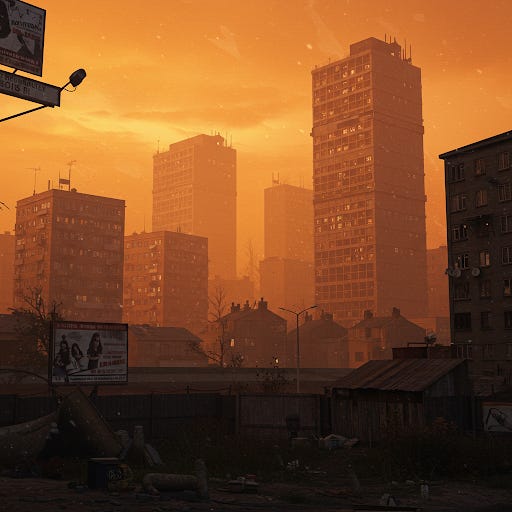Bristol Sold: How Student Landlords and Conglomerates Are Taking Over Our City.
The Great Bristol Sell-Off: Billions Pave the Way for Corporate Rule.
Bristol, a city with a small town mentality, is being relentlessly remade in the image of profit. Forget vibrant evolution; what's unfolding is a hostile takeover orchestrated by colossal landlord developers, their coffers overflowing with investment money, while the authentic heart of Bristol withers. The figures, touted as signs of progress, are in reality the gravestones of a city sold out.
The so-called "Mammoth Transformation of Bristol Temple Quarter," far from being a jewel, is a festering wound. While the promise of "up to 10,000 new homes and around 22,000 new jobs" dangles like a poisoned carrot for the better off in life, the reality is a deluge of identikit student blocks and sterile commercial zones, designed to extract maximum rent, not foster genuine community. The billions in "potential development value" translate to billions siphoned out of Bristol's economy, enriching distant shareholders while local businesses struggle to afford rising rents.
Take, for instance, Unite Students' chillingly precise £73 million Freestone Island development, delivering a staggering 500 student beds by 2026/27. This isn't about providing homes; it's about locking in guaranteed income streams, a relentless tide of transient populations prioritised over the needs of long-term Bristol residents desperate for affordable housing.
The rot spreads far beyond Temple Quarter. The much-lauded Bedminster Green regeneration, aiming for 1,303 new student bedrooms and a mere 826 new homes, alongside vague "commercial space," speaks volumes. The "substantial multi-million pound investment" across its five sites isn't about breathing new life into a neglected area for the benefit of its existing community. It's about maximizing student occupancy and squeezing in a token number of actual homes, likely priced far beyond the reach of most Bristolians. The hundreds of millions poured in here are not for the people who built Bedminster's character, but for those who will erode it.
Even the transformation of the historic Redcliff Quarter carries a sinister undertone. The "new residential units," undoubtedly carrying premium price tags, the generic "four-star hotel," the predictable chain "restaurants" and "retail" – it's a blueprint for homogenisation, erasing the unique fabric of the area. The planned Redcliffe Tower, a "multi-million pound undertaking," will stand as a monument to corporate ambition, casting a long shadow over the struggling local businesses it will inevitably dwarf.
The much-hyped YTL Arena Bristol, with its £100+ million price tag, is a shiny distraction from the real agenda. The surrounding Brabazon development by YTL, a "multi-billion pound long-term investment" in North Bristol, promises "thousands of new homes, offices, and infrastructure." But who are these homes for? And will the infrastructure truly serve the existing communities, or primarily facilitate the needs of the incoming corporate tenants and their transient workforce? The billions being thrown around here feel less like an investment in Bristol's future and more like the carving out of a privately-run satellite city, detached from the needs and concerns of the wider population.
Even the "Affordable Housing Initiatives" by Bristol City Council and its partners, while presented as a counter-narrative, feel like a drop in the ocean against the tidal wave of private development. The "tens, if not hundreds, of millions of pounds" allocated are a pittance compared to the billions being wielded by the corporate landlords. These initiatives risk becoming mere window dressing, token gestures to appease a growingly disenfranchised populace while the fundamental power structures shift irrevocably.
The "Underlying Factors Driving Investment," far from being benign market forces, are the very mechanisms of Bristol's demise:
A Robust Property Market: This isn't a sign of a healthy city; it's an indicator of rampant speculation, where housing becomes a commodity to be traded for profit, not a fundamental right.
High Demand: Fueled by the influx of students – a demographic actively courted by developers – and those priced out of London, this demand is being exploited, not met with sustainable solutions for existing residents.
Economic Vitality: The "diverse and expanding economy" increasingly caters to the needs of these very developers and their tenants, creating a self-serving ecosystem that marginalises local, independent businesses.
Strategic Location and Connectivity: These assets are being leveraged not for the benefit of Bristolians, but to attract further corporate investment, accelerating the cycle of displacement and profit extraction.
The "Bigger Picture" is not one of progress, but of a city teetering on the brink of becoming a corporate fiefdom. The billions being committed are not an investment in Bristol's soul, but a down payment on its future subjugation. The council, increasingly reliant on these massive developments for revenue and seemingly powerless to enforce meaningful regulations, risks becoming little more than a municipal service provider for the corporate entities that will ultimately dictate the city's fate.
Bristol is being built, yes, but not for Bristolians. It's being built for balance sheets and shareholder returns, a bleak monument to the power of money and the erosion of local autonomy. The vibrant spirit is being suffocated under layers of concrete and corporate branding, and the whispers of dissent are being drowned out by the relentless hum of construction – a soundtrack to the city's slow and agonising decline.



